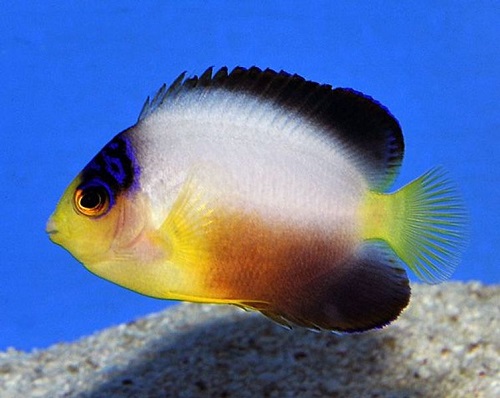Identification:
The Multicolor Angelfish, (Centropyge multicolor), is a very attractive small angel, that only grows to 3 1/2 inches. It is also known as the Pastel Pygmy Angelfish and the Many Colored Angelfish. The Multicolor Angelfish has a light pastel palet of colors: smokey white, orange,yellow, blue, black. There is also black speckles on a background of blue that highlight an area just behind the eyes. Their dorsal and anal fins are blue-black while the caudal fin is yellow. In a final contrast to its other colors, there is a horizontal splash of smokey-white from the mid-body down to the caudal fin. Splashed with a multitude of colors, this is a durable, good tempered dwarf angelfish. With Its rich color accents It makes an attractive aquarium specimen for both intermediate and advanced aquarists alike.
At one time, the Multicolor Angelfish was thought to be quite rare. It is now collected somewhat more often making it a lesser price than it used to be. It is a deep water species of Angelfish which will do best in low light aquariums. They are found living in and around deeper reef slopes, ranging from areas of rocky rubble all the way to areas of dense coral growth. In the aquarium they do need to be maintained in better water quality than what's required for most saltwater fish, so are suggested for an intermediate aquarist. But they are great little angelfish that are not too picky about what they eat and are great foragers. Their natural diet consists mostly of algae and detritus, which keeps them very active moving around picking at the substrate and the rockwork. They do best with 70 gallons or larger aquarium and if with multiple Dwarf angels we suggest 150 gallons or more. The best environment is one with live rock that can help supply them with plenty of natural algal foods, and positioned to create lots of hiding places.
The Multicolor Angelfish require lots of hiding places in a rocky Aqua-scaped aquarium with lots of caves/crevices and ample amounts of live rock for grazing on microalgae and diatoms. While they should not harm non-sessile invertebrates such as shrimp, snails or crabs. Because of the need for lower lighting levels they would not be a good reef candidate except for lower light level corals.
All Dwarf Angelfish are born female and can be paired according to size, not necessarily color. The larger fish becomes male, so making a pair is possible by buying a larger Multicolor Angelfish and a smaller one, and within a few months hopefully they will assume their roles as male and female. Dwarf angelfish will spawn in captivity and some are now being raised, yet raising the larvae is quite a difficult task.
Food and Diet:
Dwarf Angelfish are omnivore's. In the wild it feeds primarily on algae, but it will also ingest tiny animals living in the algae. In captivity their diet will be mostly algae, but also offer some other proteins. Feeding them a variety of good foods is important. Offer various types of fresh and dried marine algae, spirulina enriched foods, mysis shrimp, shaved shrimp and other high-quality meaty foods, angelfish preparations, and flakes or pellets designed for algae eating fish. There are several good commercial foods available including Formula II and Angel Formula. Feed several times a day even if natural foods are present.
Recommended amount of drip acclimation time:
3+ hours
Approximate Purchase Size:
Small 1" to 1 1/2"; Medium 1 1/2" to 2 1/2"; Large 2 1/2" to 3"
|



